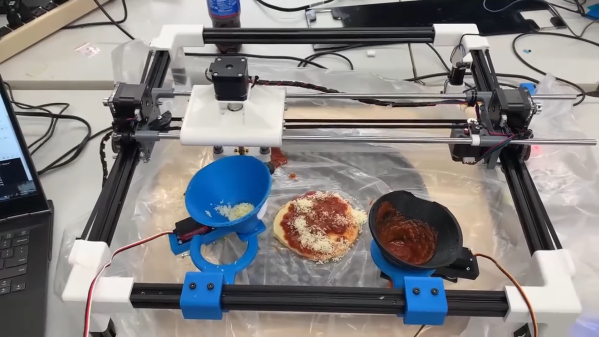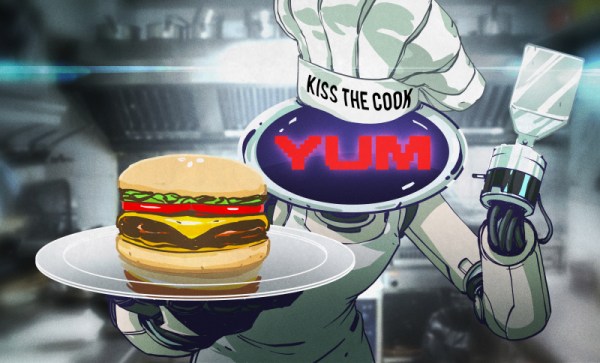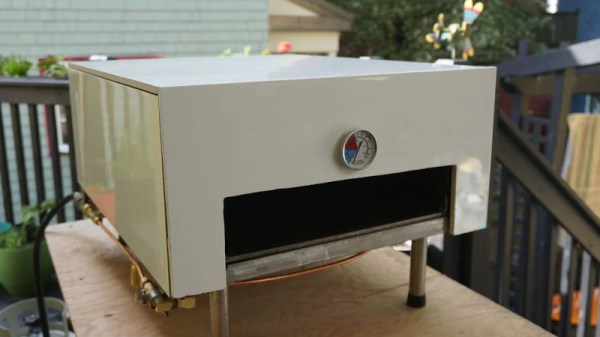As [Matt Stele] prepared to bike a local 300-mile (~480km) race in addition to training, he had to prepare for food. A full day of riding was ahead on gravel trails, and one of the best options for him was Casey’s General Store pizza. However, as it was a race, other riders were much faster than him. So, all the hot slices were gone when he arrived. With the help of a serverless GPS tracker, some cloud lambdas, and some good old-fashioned web scraping, [Matt] had a system that could order him a fresh pizza at the precise moment he needed. Continue reading “Ordering Pizza While Racing”
Pizza17 Articles
Pizza Elevator Is The Most Vital Pandemic Technology Of All
Remember the darkest days of lockdown and the pandemic? We were trying to distance ourselves from strangers wherever possible. [scealux]’s pizza elevator was spawned at this time to make apartment pizza deliveries as contactless as possible, and it’s charmingly branded to boot.
The build was intended to loft a pizza from street level to a third-floor balcony (by the American convention, ground floor is numbered one). Built with CNC-cut wooden parts, the elevator frame snap-fits on to the balcony railing. From there, a single spool runs out wire to four corners of the elevator platform.
As the crank is turned, the platform lowers under its own weight. The pizza can then be placed on the platform, and dinner can be lifted back up to the apartment. It’s a simple design, and one that manages to lift the pizza in a stable and flat fashion. With that said, we’d still like to see some anti-tip railings on a potential revision two.
Mock the branding all you will, it’s actually a smart design choice. The recognizable logo made the device’s purpose super obvious to the pizza delivery person, easing the introduction of the technology to a new user base.
If you want to make your own pizza instead of ordering out, you can automate that too.
Continue reading “Pizza Elevator Is The Most Vital Pandemic Technology Of All”
Pizza-Making CNC Machine Is The Only Tool We’ve Ever Dreamed Of
Making pizza is fun, but eating pizza is even better. Ideally, you’ll get to spend much more time doing the latter than the former. If you had a pizza-making CNC machine, that would help you achieve this goal, and thankfully, [Twarner] is working on that very technology.
The Pizza-Pizza CNC Machine is based on Marlin firmware running on a Mini RAMbo 3D printer motherboard, and is a 3-axis CNC machine. At a glance, you could be forgiven for thinking it’s some kind of fancy futuristic vinyl player, but it’s actually intended to cook a tasty delicious pie. It’s a gantry-based machine that uses two tool ends, one charged with distributing sauce, and the other cheese. It’s programmed with G-code to designate areas to coat with sauce and areas to cover with cheese. It can’t create dough from scratch sadly, but instead operates using pre-manufactured pizza bases.
The current level of sophistication is low, and there are issues with cheese clogs and the general messiness of the operation. However, this doesn’t mean there’s no value in automated pizza manufacture. If anything, we want to see the more open-sauce development in this area until we end up with a pizza factory on every kitchen bench worldwide. We’ve already seen that hackers have mastered how to build a good pizza oven, so now we just need to solve this part of the equation. Video after the break.
Continue reading “Pizza-Making CNC Machine Is The Only Tool We’ve Ever Dreamed Of”
Who Needs Yeast When You Have Lab Equipment?
This particular story on researchers successfully making yeast-free pizza dough has been making the rounds. As usual with stories written from a scientific angle, it’s worth digging into the details for some interesting bits. We took a look at the actual research paper and there are a few curious details worth sharing. Turns out that this isn’t the first method for yeast-free baking that has been developed, but it is the first method to combine leavening and baking together for a result on par with traditional bread-making processes.

Basically, a dough consisting of water, flour, and salt go into a hot autoclave (the header image shows a piece of dough as seen through the viewing window.) The autoclave pressurizes, forcing gasses into the dough in a process similar to carbonating beverages. Pressure is then released in a controlled fashion while the dough bakes and solidifies, and careful tuning of this process is what controls how the bread turns out.
With the right heat and pressure curve, researchers created a pizza whose crust was not only pleasing and tasty, but with a quality comparable to traditional methods.
How this idea came about is interesting in itself. One of the researchers developed a new method for thermosetting polyurethane, and realized that bread and polyurethane have something in common: they both require a foaming (proofing in the case of bread) and curing (baking in the case of bread) process. Performing the two processes concurrently with the correct balance yields the best product: optimized thermal insulation in the case of polyurethane, and a tasty and texturally-pleasing result in the case of pizza dough. After that, it was just a matter of experimentation to find the right balance.
The pressures (up to 6 bar) and temperatures (145° Celsius) involved are even pretty mild, relatively speaking, which could bode well for home-based pizza experimenters.
Portable Pizza Oven Has Temperature Level Over 900
While it’s possible to make pizza from scratch at home right down to the dough itself, it’ll be a struggle to replicate the taste and exquisite mouthfeel without a pizza oven. Pizzas cook best at temperatures well over the 260°C/500°F limit on most household ovens while pizza ovens can typically get much hotter than that. Most of us won’t have the resources to put a commercial grade wood-fired brick oven in our homes, but the next best thing is this portable pizza oven from [Andrew W].
The build starts with some sheet metal to form the outer and inner covers for the oven. [Andrew] has found with some testing that a curved shape seems to produce the best results, so the sheet metal goes through rollers to get its shape before being welded together. With the oven’s rough shape completed, he fabricates two different burners. One sits at the back of the oven with its own diffuser to keep the oven as hot as possible and the other sits underneath a cordierite stone to heat from the bottom. Both are fed gas from custom copper plumbing and when it fires up it reaches temperatures hot enough that it can cook a pizza in just a few minutes. With some foldable legs the oven also ends up being fairly portable, and its small size means that it can heat up faster than a conventional oven too.
This is [Andrew]’s third prototype oven, and it seems like he has the recipe perfected. In fact, we featured one of his previous versions almost two years ago and are excited to see the progress he’s made in this build. The only downside to having something like this would be the potential health implications of always being able to make delicious pizzas, but that is a risk we’d be willing to take.
Continue reading “Portable Pizza Oven Has Temperature Level Over 900”
The Ever-Accelerating Automation Of Fast Food
In the fast food industry, speed is everything. The concept has never just been about cooking quickly. Players in this competitive space spend huge fortunes every year on optimizing every aspect of the experience, from ordering, to queueing, to cleaning up afterwards. And while fast food restaurants are major employers worldwide, there’s always been a firm eye cast over the gains that automation has to offer.
Flipping Burgers
In the West, fast food most commonly brings burgers to mind. Preparing a quality burger requires attention to the grade of meat, fat content, as well as the preparation steps before it hits the grill. Then it’s all about temperature and time, and getting just the right sear to bring out the natural flavors of the beef. While a boutique burger joint will employ a skilled worker to get things just right, that doesn’t fly for fast food. Every order needs to be preparable by whichever minimum-wage worker got the shift, and be as repeatable as possible across entire countries, or even the world, to meet customer expectations.
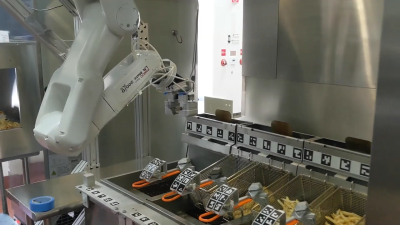
In their efforts to improve efficiency, White Castle have taken the bold step of installing a robotic burger flipper, imaginitively named Flippy. Built by Miso Robotics, the robot hangs from a ceiling rail to minimise the space taken up in the kitchen area. Based on a Fanuc robot arm, the system uses artificial intelligence to manage kitchen resources, Flippy is capable of managing both the grill and fryers together to ensure fries don’t get cold while the burgers are still cooking, for example. Currently undergoing a trial run in Chicago, White Castle has ambitions to roll the technology out to further stores if successful.
We’ve seen other robotic burger systems before, too. In late 2018, our own [Brian Benchoff] went down to check out Creator, which cooks and assembles its burgers entirely by machine. Despite suspicions about the business model, Creator have persisted until the present day with their unique blend of technology and culinary arts. Particularly impressive were their restaurant modifications in the face of COVID-19. The restaurant received an overhaul, with meals being robotically prepared directly in a take-out box with no human contact. Take-out meals are double-bagged and passed to customers through an airlock, with a positive-pressure system in the restaurant to protect staff from the outside world.
Pizzabots
Pizza is a staple food for many, with high demand and a stronger dependence on delivery than other fast food options. This has led to the industry exploring many avenues for automation, from preparation to order fulfillment.
In terms of outright throughput, Zume were a startup that led the charge. Their system involves multiple robots to knead dough, apply sauce and place the pie in the oven. Due to the variable nature sizes and shapes of various toppings, these are still applied by humans in the loop. Capable of turning out 120 pizzas per hour, a single facility could compete with many traditional human-staffed pizza shops. They also experimented with kitchens-on-wheels that use predictive algorithms to stock out trucks that cook pizzas on the way to the customer’s door. Unfortunately, despite a one-time $4 billion USD valuation, the startup hit a rocky patch and is now focusing on packaging instead.
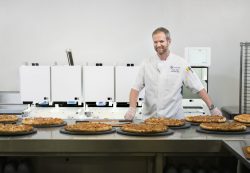
Picnic have gone further, claiming an output rate of up to 300 twelve-inch pies an hour. The startup aims to work with a variety of existing pizza restaurants, rather than striking out as their own brand. One hurdle to overcome is the delivery of a prepared pizza into the oven. There are many varieties and kinds of pizza oven used in commercial settings, and different loading techniques are required for each. This remains an active area of development for the company. The company has a strong focus on the emerging ghost kitchen model, where restaurants are built solely to fulfill online delivery orders, with no dining area.
Domino’s is one of the largest pizza companies in the world, and thus far have focused their efforts on autonomous delivery. The DRU, or Domino’s Robotic Unit, was launched to much fanfare, promising to deliver pizzas by a small wheeled robotic unit. Equipped with sensors to avoid obstacles and GPS navigation, the project has not entered mainstream service just yet. However, between this and the multitude of companies exploring drone delivery, expect to see this become more of a thing in coming years.

A more immediate innovation from Domino’s has been the DOM Pizza Checker. With customer complaints about pizza quality plaguing the chain, the pizza checker is an AI-powered visual system. It’s responsible for determining if the correct pizza has been made, with the right toppings and good distribution. An impressive practical use of AI imaging technology, it sounds an alarm if the pizza isn’t up to scratch, prompting it to be remade. However, it has come under scrutiny as a potential method to harass franchisees and workers. Additionally, the limitations of the system mean that Domino’s are still perfectly capable of turning out a bad pizza on occasion.
Other Efforts
One of the most visible examples of fast food automation is the widespread adoption of order kiosks by McDonalds, which kicked off in earnest in 2015. The majority of stores in the US now rely on these to speed up the ordering process, while also enabling more customization for customers with less fuss. Over-the-counter ordering is still possible at most locations, but there’s a heavy emphasis on using the new system.
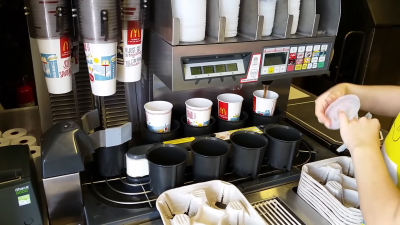
In general, online ordering and delivery has become the norm, where ten years ago, the idea of getting McDonalds delivered was considered magical and arcane. This writer made seven attempts to take advantage of an early version of the service in China in 2015, succeeding only once, largely due to a lack of understanding of addresses written in non-Latin characters. However, due to the now-ubiquitous nature of services like Ubereats, Postmates, and Menulog, it’s simple for any restaurant to largely automate their ordering and fulfillment process, and reach customers at a distance from their brick-and-mortar locations.
Other efforts are smaller in scope, but contribute to great efficiency gains back-of-house. McDonalds and other chains have widely adopted automated beverage systems. Capable of automatically dispensing cups and the requisite fluids, they take instructions directly from the digital ordering system and take the manual labor out of drink preparation. They’re also great at slightly underfilling the cups, in a way that any human would consider incredibly rude.
Conclusion
Robots in the fast-food kitchen stand to reduce or eliminate tedious, repetitive work. Robots don’t get sick, and less human labour means fewer rostering hassles. It seems to be a foregone conclusion that more automation is on the way, and while some startups may falter, others will surely succeed. Your next meal may just yet be entirely prepared by a robot, even if it’s still delivered by a tired grad student on a moped. Come what may!
Portable Pizza Oven Does The Job, And Fast
Pizza ovens are a fun thing to have in your back yard, and often wood is the fuel of choice for that smoky, rustic charm. However, [Andrew] is a fan of speed, leading him to prefer propane when it comes time to make a pizza. This guided his portable pizza oven build, with impressive results.
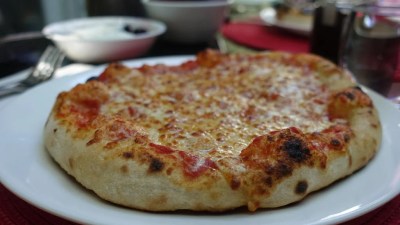
With this build, [Andrew]’s goal was to have a portable oven that didn’t sacrifice on performance. Commercial offerings were easy to lug around, but tend to cool down too much after cooking a pie, leading to lengthy waits for the oven to return to temperature. Not content to wait, [Andrew] specified his build with two custom tube burners to heat the floor, with separate jet burners to heat the cavity. When two jets proved too much, he refined the design to just one to improve efficiency and reduce carbon build up.
The Instructable is a great read, covering both the design of the oven as well as the necessary techniques to cook high-quality Neapolitan pizzas in minutes flat – right down to the selection of flour and proper insertion techniques to avoid sticking. The home pizza enthusiast could learn a lot here, and it’s great to see [Andrew] continue to improve on his earlier designs. Video after the break.
This is only the most recent of many pizza ovens to grace these pages. How about one in a beer keg?
Continue reading “Portable Pizza Oven Does The Job, And Fast”



